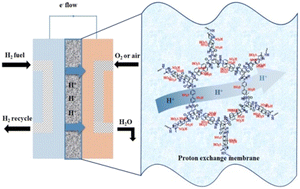Facile construction of a highly proton-conductive matrix-mixed membrane based on a –SO3H functionalized polyamide†
Abstract
Developing a facile strategy to construct low-cost and efficient proton-conductive electrolytes is pivotal in the practical application of proton exchange membrane (PEM) fuel cells. Herein, a polyamide with in-built –SO3H moieties, PA(PhSO3H)2, was synthesized via a simple one-pot polymeric acylation process. Investigations via electrochemical impedance spectroscopy (EIS) measurements revealed that the fabricated PA(PhSO3H)2 displays a proton conductivity of up to 5.54 × 10−2 S cm−1 at 353 K under 98% relative humidity (RH), which is more than 2 orders of magnitude higher than that of its –SO3H-free analogue PA(Ph)2 (2.38 × 10−4 S cm−1) under the same conditions. Therefore, after mixing with polyacrylonitrile (PAN) at different ratios, PA(PhSO3H)2-based matrix-mixed membranes were subsequently made and the analysis results revealed that the proton conductivity can reach up to 5.82 × 10−2 S cm−1 at 353 K and 98% RH when the weight ratio of PA(PhSO3H)2 : PAN is in 3 : 1 (labeled as PA(PhSO3H)2–PAN(3 : 1)), the value of which is comparable even to those of commercially available electrolytes that are used in PEM fuel cells. In addition, continuous testing shows that PA(PhSO3H)2–PAN(3 : 1) possesses long-life reusability. This work demonstrates that, utilizing the simple reaction of polymeric acylation with a sulfonated module as a precursor, highly effective proton-conductive membranes for PEM fuel cells can be achieved in a facile manner.



 Please wait while we load your content...
Please wait while we load your content...